Slow Flowers Community members share insights about U.S.-grown roses
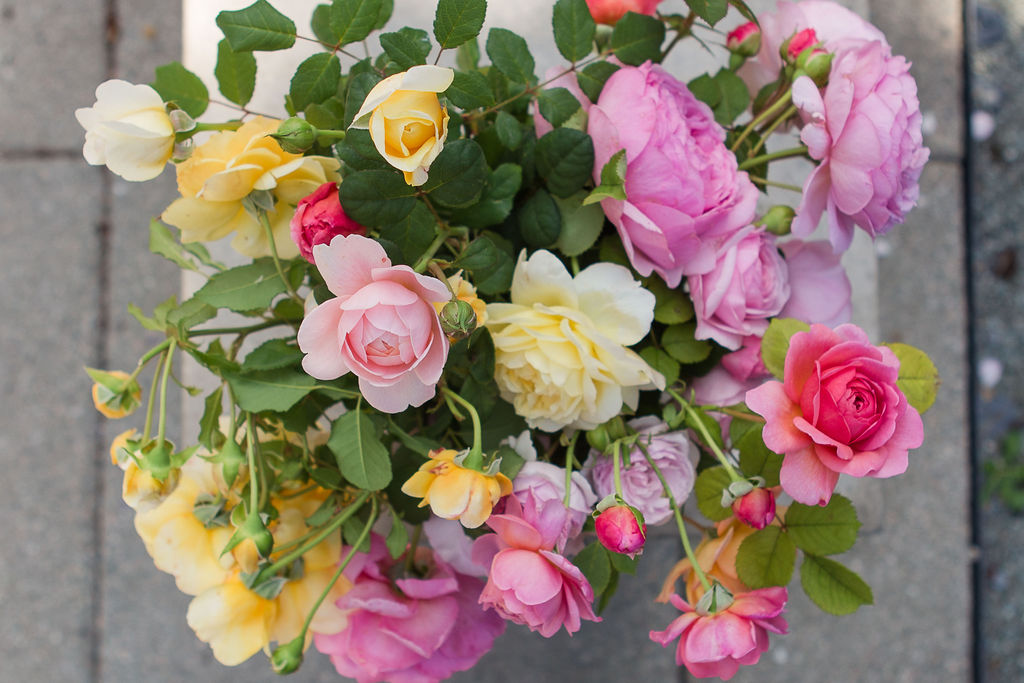
In early November, the U.S. Trade Representative lifted long-standing 6.8% duties on imports of cut roses from Ecuador. While this is disheartening news, we believe the Slow Flowers community is well-positioned to surmount marketplace challenges such as unfair trade policy with creativity, product quality, product variety and a story of origin.
Here are two industry articles discussing the pros and cons of this decision:
Society of American Florists, “With Addition of Roses to GSP, Industry Businesses Stand to Save Millions”
Capital Press, “American Rose Growers Criticize USTR Decision to Remove Tariff Protection”
To collect our thoughts about the strength of the U.S. rose-growing landscape, we asked members and followers to participate in a short survey. Ninety people took the time to respond and their insights are reflected below — more than 10% of Slow Flowers membership. Read on to learn more!
How I categorize my floral enterprise
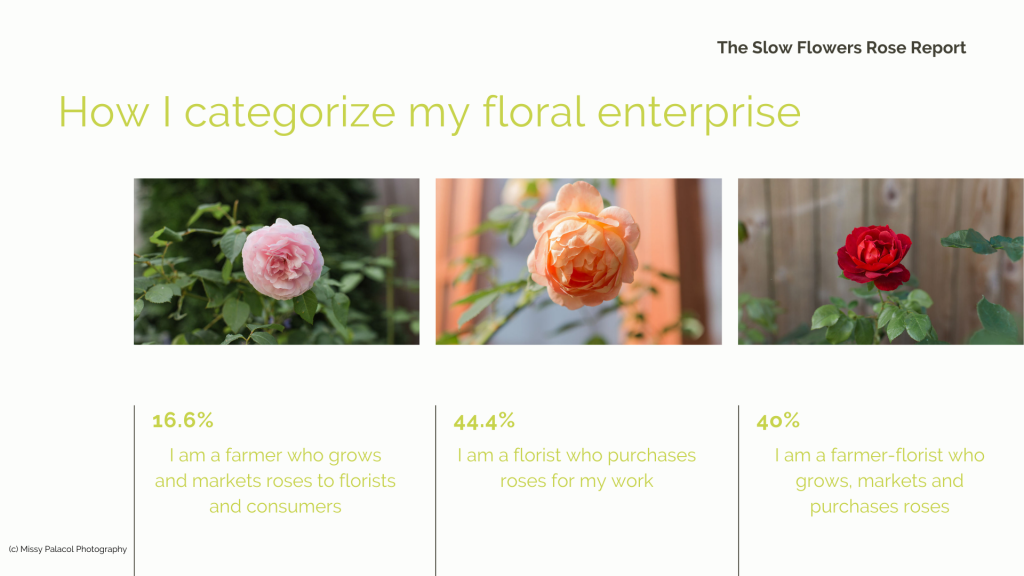
Percentage of my rose purchases originating from domestic farms and U.S. growers
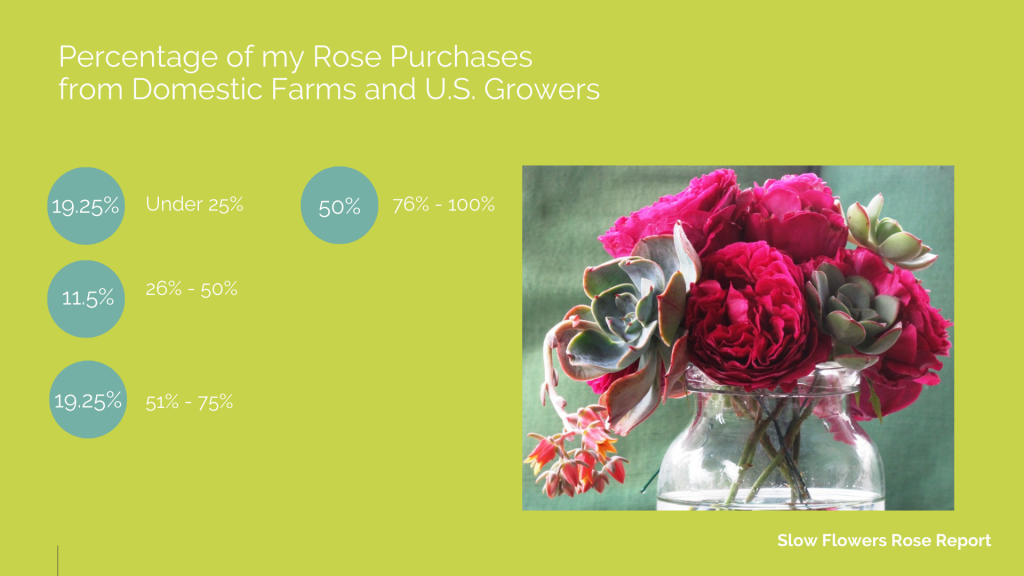
Sources of the roses I purchase
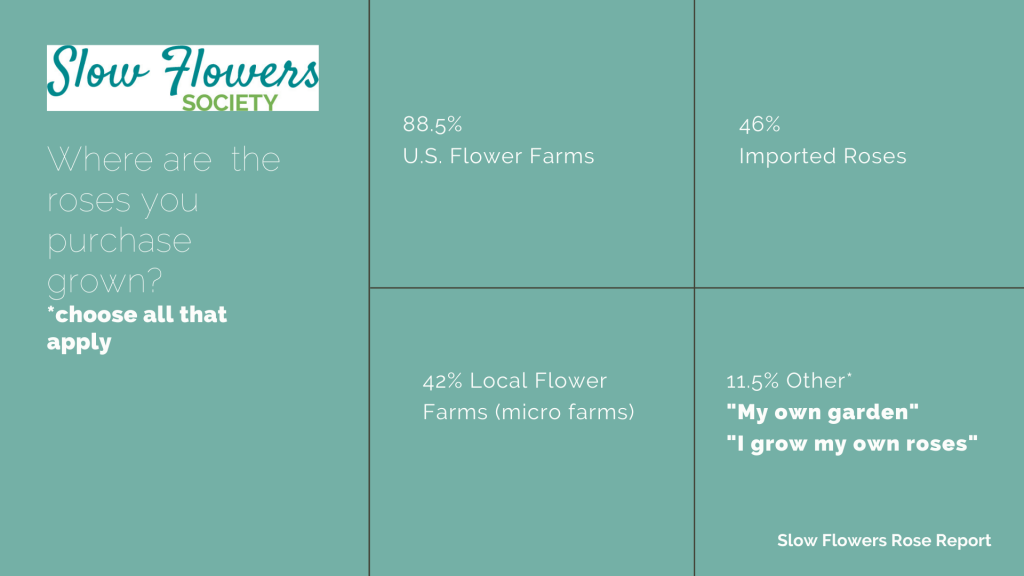
Types of domestic roses I purchase
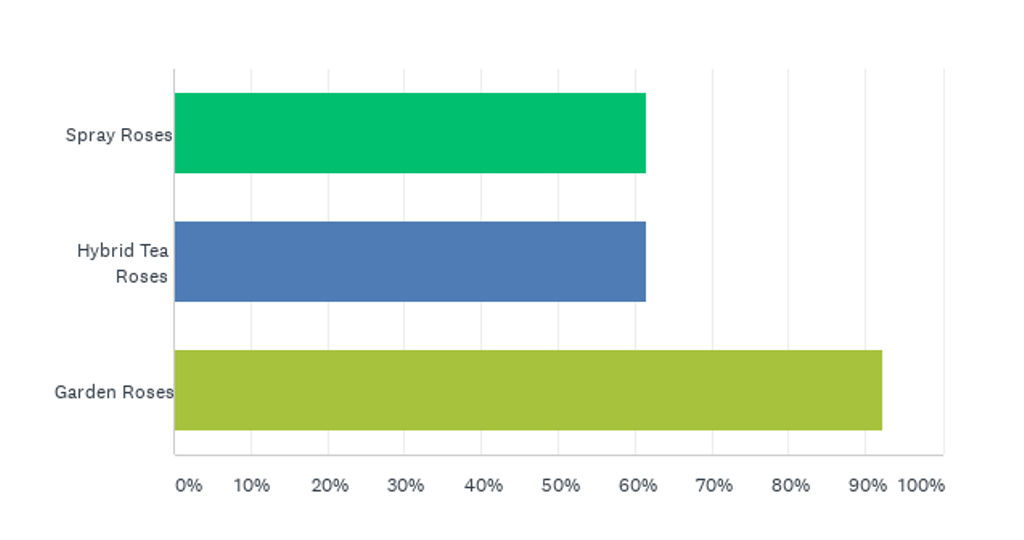
(Florists): Reasons I purchase domestic roses
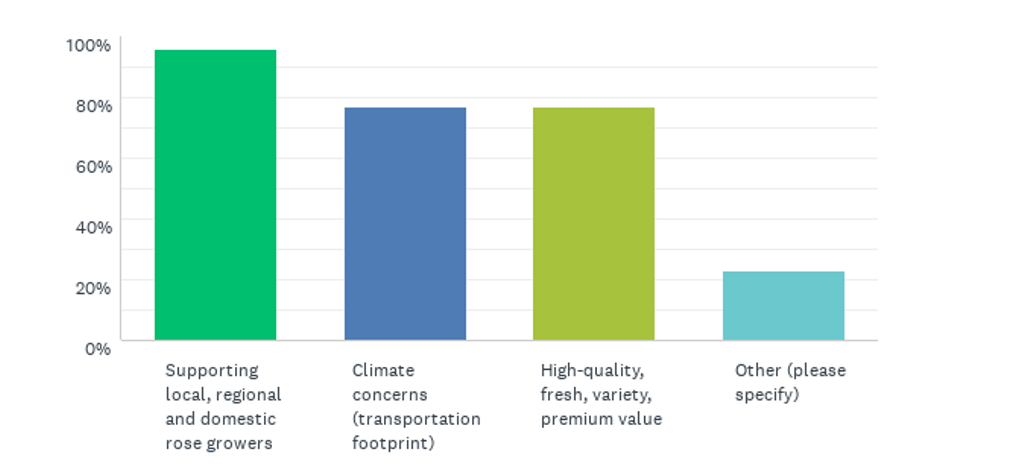
“Other” reasons include:
“To supplement our harvest.”
“Concern over how labor is treated in other countries.”
“Seasonal availability.”
“Scent.”
“Unusual varieties and colors.”
” Unique varietals, fragrance.”
(Farmers): Reasons I grow domestic roses
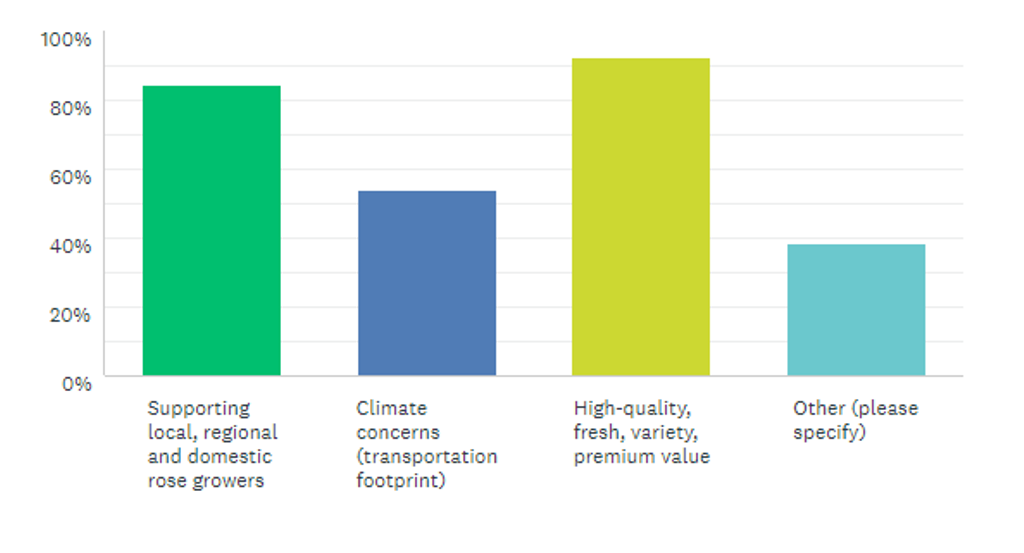
“Other” reasons include:
“Their personality, scent and fall-in-love qualities.”
“I do not believe in use of chemicals and pesticides.”
“I use little or no chemicals on the roses I grow.”
“Differentiation.”
Here’s how my business practices will be influenced by the USTR decision to lift tariffs on Ecuador roses
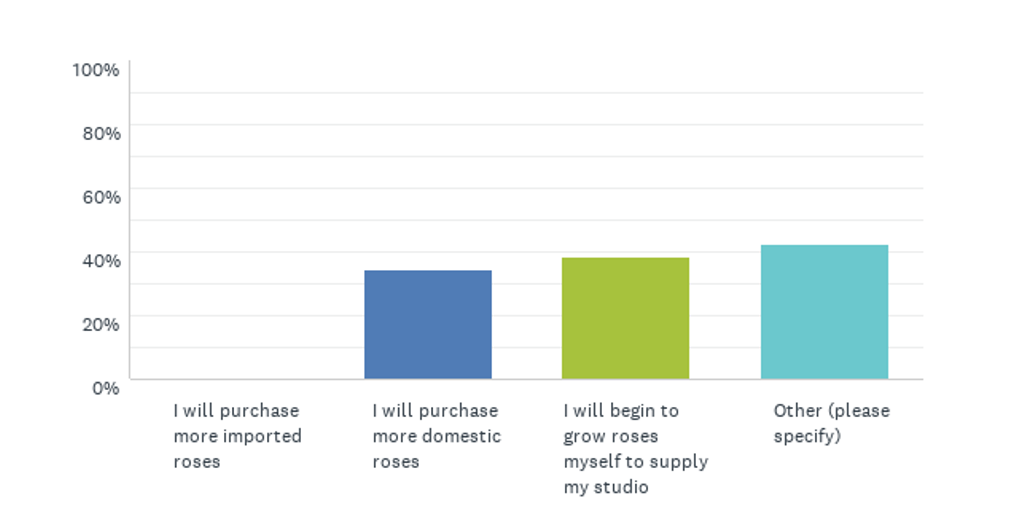
Comments:
“I already grow my own. I may grow more if the market will not support costs of importing from other local and California-growers.”
“It won’t make a big difference; I still try to buy more U.S.-grown roses when possible.”
“I will continue to grow my own roses, but I will now have higher margins on any imported that I use. It won’t change my business model of focusing on locally grown flowers.”
“I don’t think it will change my buying habits. I prefer to purchase local and/or U.S.- grown roses, but I go outside that to procure unusual roses within bridal requests.”
Here’s the average price per stem I pay for U.S.-grown roses:
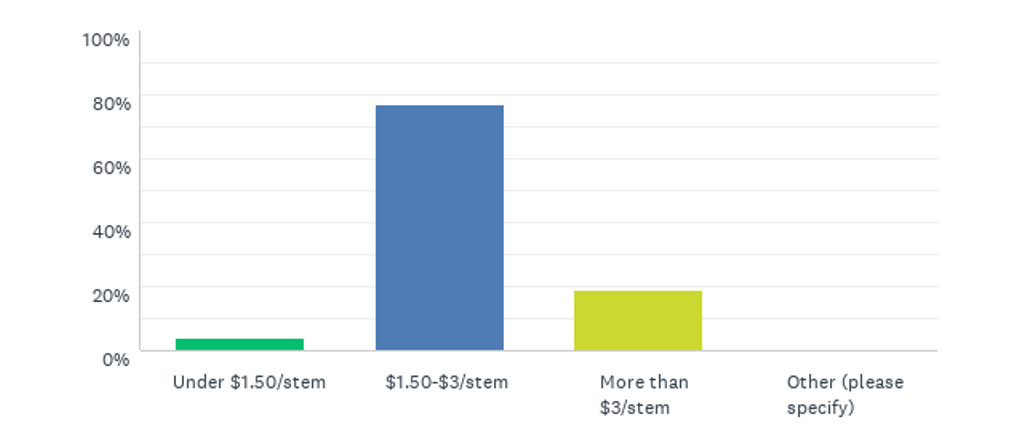
Here’s how I believe my customers’ buying practices will be influenced by the USTR decision to lift tariffs on Ecuador roses
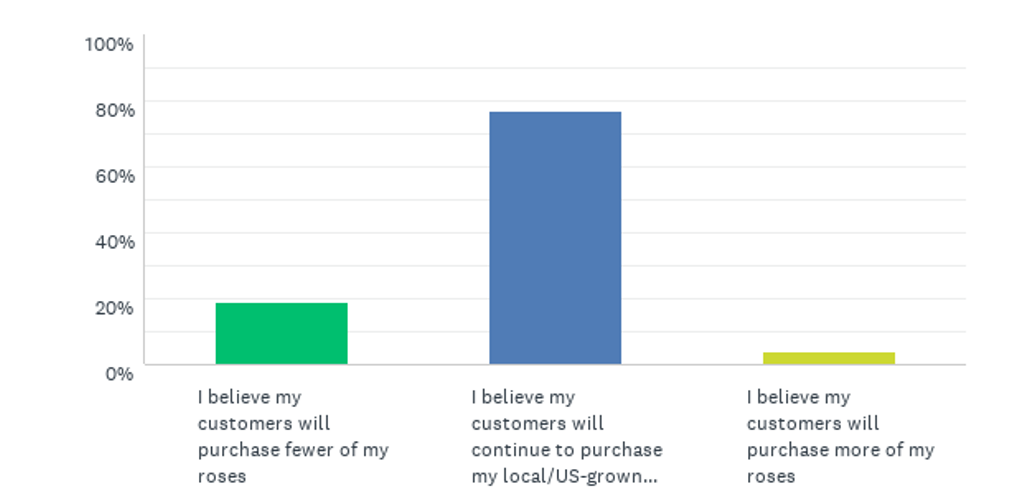
How do U.S.-grown roses compare to Imported roses?
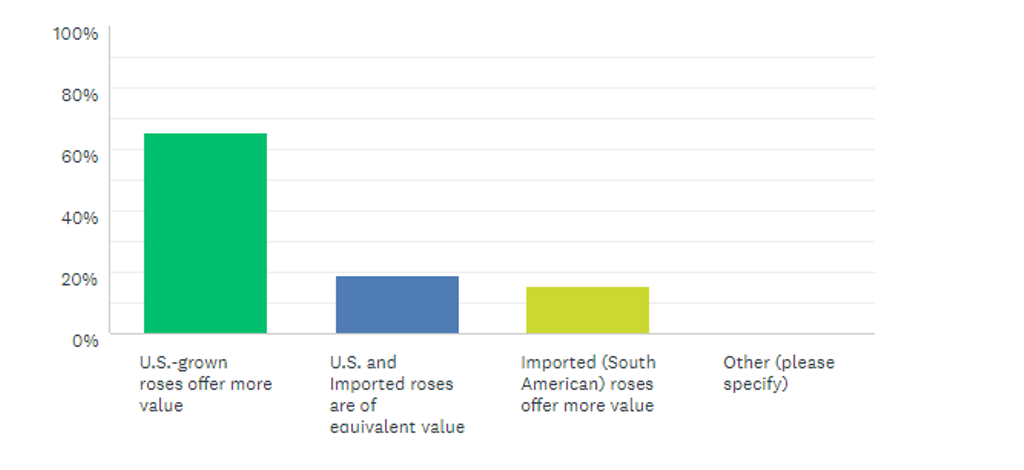
My outlook for U.S.-grown roses

Comments:
“The cost of domestic roses is quite a bit more the imported ones. Cost is a big factor for me as many of my clients are looking for flowers that are affordable. It is my job to explain why domestic flowers are a better value even though they cost more. I definitely see an interest in domestic roses, but the price tag is often what holds my clients back from selecting the domestic roses.”
“I purchase domestic roses because they’re grown here and they’re beautiful, but they do cost more. Anytime I have the budget to purchase U.S.-grown roses, I do and will continue to do so.”
“In my world, we are talking about two different products. Locally-grown garden roses vs. imported commodity roses are like Moët Chandon compared to Korbel.”
“In the northeast it is not profitable to grow roses due to high energy costs The local growers here on Long Island went out of business years ago.”
“It really is a temptation to use mainly imported (roses) because of the lower cost! For most other blooms I have found local sources, or I grow for myself, but roses are tough, especially with the variety shortage right now. Considering the effects of the heavy pesticides plus the environmental impact keeps me buying California roses.”
“My real response to your questions is “none of the above.” I know from years of growing our Kordes garden roses that our “regular” florist customers buy our roses as special treats and for certain niche customers only. Our roses will never replace everyday roses wherever they are coming from; ours are too expensive and very much a specialty crop. I imagine florists buy their everyday roses from whoever offers the best quality at the best price, reflecting personal judgment and especially reflecting their personalized relationship with individual wholesale providers. I don’t know how our florists weigh in on South American versus U.S. grown roses. The second customer niche for our garden roses is for weddings and special events. These are sold to mostly one-time customers who buy based on look and immediate gratification. We can alter that look by picking the roses at different stages of maturity depending on their eventual application; thus, heightening their appeal. Most of these general public customers “fall” for the roses and are also making a very conscious decision to buy locally grown.”
“It’s hard to say. I know that garden roses are harder to ship and we may maintain a foothold in that market. For customers who value fragrance and romantic roses, they will continue buying from us.”
“I believe domestic Roses offer more value. However, I know my values about the environment and pesticide use are not shared by everyone. And some of the florists who appreciate garden roses will still buy more roses from South America regardless of chemicals and pesticides and carbon footprint.
I have decided I will only sell my flowers to florists who believe in global warming and who do not use floral foam.”
“‘Value’ is subjective – quantity vs. cost or longevity vs. cost or fragrance vs. cost or overall earth effects vs. cost? My farm is small; my market is as well. I enjoy my direct-to-consumer relationships. Wholesalers and florists here already prefer low-cost and quantities of roses for over-the-top events. They don’t really seem to care about every day consumers. There are lots of cheap imports and fillers available and consumers rarely know the difference. My clients are first struck by the fragrance then stay for the environmental value. I couldn’t compete with imports before and I won’t even think about it now. Disappointed that even Whole Foods & Sprouts don’t care about local seasonal flowers here. When this legislation popped on my radar, one rose grower I contacted could have cared less. They did not feel it would affect them at all because they are ‘such a big grower.'”
“I grow roses that don’t ship well, that are grown using organic/sustainable practices, and can be harvested at their peak freshness. Plus, the customer service that I can offer to a florist is invaluable. For example, they can send me their color palette and I can suggest the best roses. That way, florists learn new rose varieties and I can help them elevate their creations with unique rose shades and forms. For instance, roses change color throughout the season and in extreme heat/cold. A Honey Dijon rose can turn lavender-colored in heat, for instance. If a florist is requesting Koko Loco roses, I can suggest the heat-tinted Honey Dijons in this case.”
“The lifting of the tariff can perhaps be used as a talking point when selling domestic roses – I will use it as a way to educate end users about the issues and the reasons why buying local is good for everyone.
Local products have the added value of benefiting the economy, which benefits everyone, especially in these uncertain times.”
“I think this is disheartening news. Florists may trend away from domestic roses to cheaper imports even though the quality is inferior and the impacts are terrible. But with concentrated education we can push back on the initial surge to return interest and purchasing power back to domestic roses.”
“Cost continue to rise and it squeezes margins. There is a strong interest in garden-looking sprays. This niche continues to have a place in the market.”
“I would guess that this ruling would have a particularly harmful impact on new customers who are considering switching to U.S.-grown roses, but in a year where margins are already slim, many florists who likely do see the value in U.S.-grown product are going to be price sensitive and would be more likely to source based on cost.”
“The garden rose ‘look’ is dramatically different than the commercial imported red rose. My clients prefer the garden rose look and in particular, their signature and heirloom scent. There will always be a market for the commonly imported rose—with the majority of those purchasers being gift-givers who think ‘a rose is just a rose is just a rose.’ Additionally, the garden rose isn’t the type to be mass-produced overseas – at least not currently, and it would take some time before they could adjust production (if they were even inclined to do so). I think American farmers are well positioned, with added emphasis individually and as a collective, we can demonstrate the value of garden vs. mass produced scentless options.”
“My hope is that florists will see the benefits locally-grown U.S. roses. They are fresher, usually have a wonderful scent and decrease our carbon footprint on the world.”
“I want to support U.S. roses but the growers need to improve the supply chains.”
“Domestic is my preference; there is no need to buy roses from other countries when we can grow beautiful roses here!”
“The supply is low and the price is high. It is tough to plan ahead.”
“I feel the domestic rose market is poised to do very well in the coming decades.”
“I love domestic roses for event work, especially garden and tea roses from suppliers like Rose Story Farm and Grace Rose Farm. However, I use imported roses when a client’s budget cannot accommodate those higher priced stems, or if I’m creating something for a birthday or anniversary, when the client expects a longer lasting product with more hardiness. Educating the consumer on the differences is tough, and until there is a unified (marketing) effort about differences and value of domestic roses, I worry most will choose the cheaper imported stems.”
“I would love to buy more if I can find quality lower shipping prices.”
“I only source U.S.-grown flowers. Most of my flowers are purchased within 30 miles of my home. Roses are the only flowers I ever order out of state, mostly from California or Oregon, because the quality and quantity so far are best from farms there. I’d love to see more East coast rose growers. I grow a lot of David Austen roses for my work.”
“Love domestic roses. Love supporting local farms. Blessed to be in a location where I get the roses come to my doorstep with no shipping and handling costs, fresh direct from the farm.”
“I wish there was more year-round availability.”
“Thank you for sending this information. Roses are the product I feel most guilty about when designing. I try to find and buy local, when possible, but at my market, imported roses are over 90% of what’s available. I’m going to alert my market of my concerns and see what efforts we can make together to find a domestic grower who can also be competitive in price.”
“I really miss imported roses. They are larger, and I used to write my recipes with roses as a base, to set my color palette. But as a conscientious buyer, as someone who is concerned about the carbon footprint of my business, as someone who wants to support small businesses and local farms, I can no longer buy the imports. I’d rather change the way I use roses, than use the imports any longer.”
“I wish there were more options for something local. For all other flowers, I buy exclusively local during the growing season. But for roses, without rose farmers on the East coast, it’s impossible for me to experiment with the use of West coast roses if I have to charge customers $9+ per stem.”
“I love them. I really only buy domestic if I need a high volume of roses for an event.”
“I prefer to use U.S.-grown roses but frequently cost is a factor for why I outsource them. I also have started growing my own for this reason, as well as because there are not enough local rose options. Shipping can be very expensive.”
“It’s disheartening. Since I started as a sustainable florist I’ve seen numerous of my local large production farms and growers go out of business. I’m hopeful, that with the quality and increased variety of the one mass rose grower left at San Francisco Flower Market, they will continue doing well. Small farms and specialty rose growers (like Green Valley for David Austen Roses) have a niche, so it seems if you can carve out how you’re offerings are unique and different as well as more sustainable, business will follow.”
“I look forward to U.S. growers continuing to grow and research new varieties and sustainable growing practices so their domestic roses are as desirable as imports.”
“U.S. and imported roses have completely different uses for me. I use imported when I cannot source domestically to get what a client wants, particularly if they do not have budget for $3.50-$4/stem roses ($12/stem with markup) or it’s the winter when there are so few things available. But I do support local growers when budget and seasonality allow it, which is most of the time. I try to source standard rose stems domestically, but I have had issues with orders coming in short and botrytis on petals. Domestic rose growers cannot be sending out sub-par products at higher prices if they want to compete! I also think more rose growers need to test out growing some standard roses to compete. I realize garden roses probably make bank, but we need all kinds of roses, not just $4/stem roses. There are only a handful of domestic farms doing standard rose production really well so there is a lot of room for growth there. And as always, farmers need to tell their stories and help florists educate consumers on the true cost of flowers so we get fewer potential clients with a $1,000 budget asking for a rose-filled wedding. I think domestic rose growers can compete on quality, varieties, and environmental concerns easily. But price is hard. I think doing more standard rose production would help close the price gap between foreign and domestic. It’s easy to spend an extra $5/bunch to support local farms. It’s much harder when the gap is $20 or more per bunch. Not every wedding is a luxury wedding and not every client is willing to foot that bill.”
“It’s concerning for sure. I want to help and source directly from domestic farmers more, but how? The price keeps increasing.”
“I don’t think it’s going to change at all. Most imported roses have always been cheaper so it just makes them even more so by a few cents a stem. If you’ve been buying domestically previously, you’ll most likely continue to do so at the same rate. And same with imported.”
“While I love domestic roses, the limited access to high quality U.S. blooms and the high cost associated with them makes it difficult for me to purchase them and remain profitable. All of my spray roses are U.S. grown, and some of my garden roses. Also, many of my customers are looking for standard roses, and imported roses meet their needs the best.”
“Imported roses are workhorse roses bred for longevity. If I ever purchase any, which is rarely, I ensure that they are green/eco. But I’m not sure how much weight that carries because I don’t know how stringent the guidelines are.”
“Domestic roses are fresher and more sustainable. I will continue to purchase them for my work; not imported roses. We cannot afford the cost to the planet or the low pay to the farmers in Ecuador, to import flowers cheaply.”
“I’m hopeful more U.S. farms will start growing roses.”
“I really hope we can continue to see domestic rose farms. The quality is generally less reliable than South American roses, unfortunately. The roses tend to have more bruising in shipment, and they don’t have the same vase life. Ironically, I tend to see that as a sign that they are HEALTHIER (because they weren’t grown with as many pesticides or whatever causes the South American roses to be so freakishly long lasting), but I don’t think the average consumer views it that way.”
Sharing a great post written by Slow Flowers member Jennifer McClendon, flower farmer and florist at JenniFlora, entitled: “Local Advantage.”
“Yes, our roses do cost more than imported options. That cost is what’s required to continue to grow the highest quality roses possible using sustainable practices, a cost I’m not willing to compromise on. I feel confident our customers will continue to value and support our farm into the future despite lower cost options being available in the market.”
Jennifer McClendon, jenniflora

